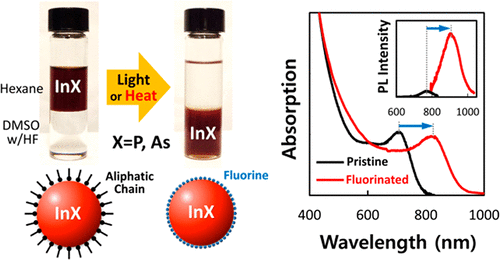Our official English website, www.x-mol.net, welcomes your
feedback! (Note: you will need to create a separate account there.)
Trap Passivation in Indium-Based Quantum Dots through Surface Fluorination: Mechanism and Applications
ACS Nano ( IF 15.8 ) Pub Date : 2018-10-16 00:00:00 , DOI: 10.1021/acsnano.8b06692 Tae-Gon Kim 1, 2 , Danylo Zherebetskyy 3 , Yehonadav Bekenstein 2, 3 , Myoung Hwan Oh 2, 3 , Lin-Wang Wang 3 , Eunjoo Jang 1 , A. Paul Alivisatos 2, 3, 4
ACS Nano ( IF 15.8 ) Pub Date : 2018-10-16 00:00:00 , DOI: 10.1021/acsnano.8b06692 Tae-Gon Kim 1, 2 , Danylo Zherebetskyy 3 , Yehonadav Bekenstein 2, 3 , Myoung Hwan Oh 2, 3 , Lin-Wang Wang 3 , Eunjoo Jang 1 , A. Paul Alivisatos 2, 3, 4
Affiliation

|
Treatment of InP colloidal quantum dots (QDs) with hydrofluoric acid (HF) has been an effective method to improve their photoluminescence quantum yield (PLQY) without growing a shell. Previous work has shown that this can occur through the dissolution of the fluorinated phosphorus and subsequent passivation of indium on the reconstructed surface by excess ligands. In this article, we demonstrate that very significant luminescence enhancements occur at lower HF exposure though a different mechanism. At lower exposure to HF, the main role of the fluoride ions is to directly passivate the surface indium dangling bonds in the form of atomic ligands. The PLQY enhancement in this case is accompanied by red shifts of the emission and absorption peaks rather than blue shifts caused by etching as seen at higher exposures. Density functional theory shows that the surface fluorination is thermodynamically preferred and that the observed spectral characteristics might be due to greater exciton delocalization over the outermost surface layer of the InP QDs as well as alteration of the optical oscillator strength by the highly electronegative fluoride layer. Passivation of surface indium with fluorides can be applied to other indium-based QDs. PLQY of InAs QDs could also be increased by an order of magnitude via fluorination. We fabricated fluorinated InAs QD-based electrical devices exhibiting improved switching and higher mobility than those of 1,2-ethanedithiol cross-linked QD devices. The effective surface passivation eliminates persistent photoconductivity usually found in InAs QD-based solid films.
中文翻译:

通过表面氟化作用使铟基量子点中的阱钝化:机理和应用
用氢氟酸(HF)处理InP胶体量子点(QD)是提高其光致发光量子产率(PLQY)而无需生长外壳的有效方法。先前的工作表明,这可以通过氟化磷的溶解以及随后铟在过量的配体上在钝化后的表面上的钝化而发生。在本文中,我们证明了通过不同的机制,在较低的HF暴露下会发生非常显着的发光增强。在较低的HF暴露下,氟离子的主要作用是以原子配体的形式直接钝化表面的铟悬挂键。在这种情况下,PLQY的增强伴随着发射峰和吸收峰的红移,而不是由蚀刻引起的蓝移,如在较高的曝光下所看到的。密度泛函理论表明,表面氟化在热力学上是优选的,并且观察到的光谱特性可能是由于InP QD的最外层表面上更大的激子离域以及高电负性氟化物层改变了光学振荡器的强度。表面氟化物对铟的钝化可以应用于其他基于铟的量子点。InAs QD的PLQY也可以增加一个数量级 表面氟化物对铟的钝化可以应用于其他基于铟的量子点。InAs QD的PLQY也可以增加一个数量级 表面氟化物对铟的钝化可以应用于其他基于铟的量子点。InAs QD的PLQY也可以增加一个数量级通过氟化。我们制造的氟化InAs QD基电子器件比1,2-乙二硫醇交联QD器件具有更高的开关性能和更高的迁移率。有效的表面钝化消除了通常在基于InAs QD的固态膜中发现的持久光电导性。
更新日期:2018-10-16
中文翻译:

通过表面氟化作用使铟基量子点中的阱钝化:机理和应用
用氢氟酸(HF)处理InP胶体量子点(QD)是提高其光致发光量子产率(PLQY)而无需生长外壳的有效方法。先前的工作表明,这可以通过氟化磷的溶解以及随后铟在过量的配体上在钝化后的表面上的钝化而发生。在本文中,我们证明了通过不同的机制,在较低的HF暴露下会发生非常显着的发光增强。在较低的HF暴露下,氟离子的主要作用是以原子配体的形式直接钝化表面的铟悬挂键。在这种情况下,PLQY的增强伴随着发射峰和吸收峰的红移,而不是由蚀刻引起的蓝移,如在较高的曝光下所看到的。密度泛函理论表明,表面氟化在热力学上是优选的,并且观察到的光谱特性可能是由于InP QD的最外层表面上更大的激子离域以及高电负性氟化物层改变了光学振荡器的强度。表面氟化物对铟的钝化可以应用于其他基于铟的量子点。InAs QD的PLQY也可以增加一个数量级 表面氟化物对铟的钝化可以应用于其他基于铟的量子点。InAs QD的PLQY也可以增加一个数量级 表面氟化物对铟的钝化可以应用于其他基于铟的量子点。InAs QD的PLQY也可以增加一个数量级通过氟化。我们制造的氟化InAs QD基电子器件比1,2-乙二硫醇交联QD器件具有更高的开关性能和更高的迁移率。有效的表面钝化消除了通常在基于InAs QD的固态膜中发现的持久光电导性。











































 京公网安备 11010802027423号
京公网安备 11010802027423号